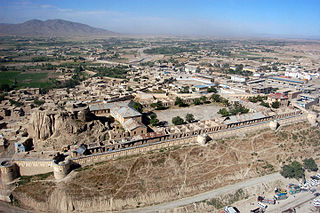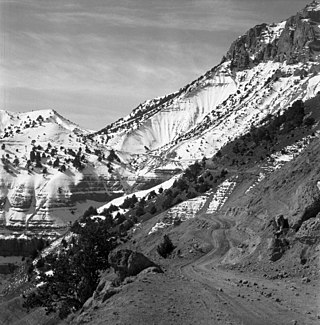
The International Security Assistance Force (ISAF) was a multinational military mission in Afghanistan from 2001 to 2014. It was established by United Nations Security Council Resolution 1386 pursuant to the Bonn Agreement, which outlined the establishment of a permanent Afghan government following the U.S. invasion in October 2001. ISAF's primary goal was to train the Afghan National Security Forces (ANSF) and assist Afghanistan in rebuilding key government institutions; it gradually took part in the broader war in Afghanistan against the Taliban insurgency.

Paktia is one of the 34 provinces of Afghanistan, located in the east of the country. Forming part of the larger Loya Paktia region, Paktia Province is divided into 15 districts and has a population of roughly 623,000, which is mostly a tribal society living in rural areas. Pashtuns make up the majority of the population and a small percentage include Tajiks. Gardez is the provincial capital. The traditional food in Paktia is known as (dandakai) which is made from rice and mung bean or green gram.

The Taliban insurgency began after the group's fall from power during the 2001 War in Afghanistan. The Taliban forces fought against the Afghan government, led by President Hamid Karzai, and later by President Ashraf Ghani, and against a US-led coalition of forces that has included all members of NATO; the 2021 Taliban offensive resulted in the collapse of the government of Ashraf Ghani. The private sector in Pakistan extends financial aid to the Taliban, contributing to their financial sustenance.

Operation Medusa was a Canadian-led offensive during the second Battle of Panjwaii of the War in Afghanistan. The operation was fought primarily by the 1st Battalion, The Royal Canadian Regiment Battle Group and other elements of the International Security Assistance Force, supported by the Afghan National Army and a team from the United States Army's 1st Battalion, 3rd Special Forces Group (Airborne) augmented by C Company, 2nd Battalion, 87th Infantry Regiment of the 10th Mountain Division. Its goal was to establish government control over an area of Kandahar Province centered in the district of Panjwayi some 30 kilometres (19 mi) west of Kandahar city. A tactical victory, it resulted in the deaths of 12 Canadian soldiers; five during the major combat operations, five in bombings, and two in a mortar/RPG attack during the reconstruction phase of the operation. Fourteen British military personnel were also killed when their plane crashed. Despite suffering a brutal battlefield defeat, the Taliban retained their presence in Kandahar province and did not lose their will to fight, leading to the subsequent Operation Falcon Summit. Nonetheless, Operation Medusa was at the time the most significant land battle ever undertaken by NATO.

Operation Mountain Fury was a NATO-led operation begun on September 16, 2006 as a follow-up operation to Operation Medusa, to clear Taliban insurgents from the eastern provinces of Afghanistan. Another focus of the operation was to enable reconstruction projects such as schools, health-care facilities, and courthouses to take place in the targeted provinces.

Operation Herrick was the codename under which all British operations in the War in Afghanistan were conducted from 2002 to the end of combat operations in 2014. It consisted of the British contribution to the NATO-led International Security Assistance Force (ISAF), and support to the American-led Operation Enduring Freedom (OEF), within the South Asian country.

Musa Qala is a town and the district centre of Musa Qala District in Helmand Province, Afghanistan. It is located at 32.4433°N 64.7444°E and at an altitude of 1,043 m in the valley of Musa Qala River in the central western part of the district. Its population has been reported in the British press to be both 2,000 and 20,000. It is in a desolate area, populated by native Pashtun tribes.

Operation Achilles was a NATO operation, part of the War in Afghanistan. Its objective was to clear Helmand province of the Taliban. The operation began on March 6, 2007. The offensive is the largest NATO-based operation in Afghanistan to date. NATO officials reported that, contrary to previous operations, Taliban fighters were avoiding direct confrontation in favor of guerilla tactics.
The following lists events that happened during 2004 in Afghanistan.

The Helmand province campaign was a series of military operations conducted by the International Security Assistance Force (ISAF) forces against Taliban insurgents and other local groups in the Helmand Province of Afghanistan. Their objective was to control a province that was known to be a Taliban stronghold, and a center of opium production. None of the ISAF's intended strategic and political objectives were achieved in the long term.
United States and NATO International Security Assistance Force (ISAF) operations, alongside Afghan National Army forces, continued against the Taliban through 2008.
The border skirmishes between the United States and Pakistan were the military engagements and confrontations between Pakistan and the United States that took place along the Afghanistan-Pakistan border from late 2008 to late 2012 resulting in the deaths of 55 Pakistani personnel with a unknown number of U.S. casualties. These incidents involved the U.S. Forces-Afghanistan Command and ISAF forces, who had been present in Afghanistan fighting Taliban and al-Qaeda insurgency, and the unified Western military command of the Pakistan Armed Forces against one another in a series of skirmishes that ceased shortly after the 2011 NATO attack in Pakistan. The two sides ultimately made peace and continued collaboration operations against insurgent groups in Pakistan following an official, however brief, apology from then-U.S. Secretary of State Hillary Clinton on 3 July 2012 over the loss of life suffered by the Pakistani military.

The Balamorghab ambush occurred on 27 November 2008, when vehicles carrying Afghan security forces were attacked by Taliban insurgents led by Ghulam Dastagir. The ambush took place near Balamorghab in Badghis Province, in northwestern Afghanistan, and resulted in heavy casualties for the government forces. It was described as "one of the most humiliating attacks the Afghan security forces had ever suffered".

The siege of Musa Qala took place between July 17 and September 12, 2006 in Afghanistan's Helmand province. A small force of International Security Assistance Force (ISAF) troops and Afghan security forces were besieged by Taliban insurgents inside the district centre of Musa Qala.

The Khost-Gardez Pass, frequently abbreviated as the K-G Pass, and known locally as the Seti-Kandow Pass, or the Satukandav Pass by Soviet forces, is the main land route connecting Khost, the capital of Khost Province, and Gardez, the capital of Paktia province, in eastern Afghanistan. The pass currently consists of a rutted dirt road, though it is slowly being improved by construction crews as part of the international reconstruction effort in Afghanistan.
Events from the year 2009 in Afghanistan
Events from the year 2011 in Afghanistan.
The following lists events from 2014 in Afghanistan.
The following lists events that happened in 2013 in Afghanistan.

Sabzak Pass is a mountain pass in Afghanistan. It is located in the mountain range of Paropamisu, north of Herat and south of Badghis of Paropamisu. It has an altitude of 2517 metres from sea level.












